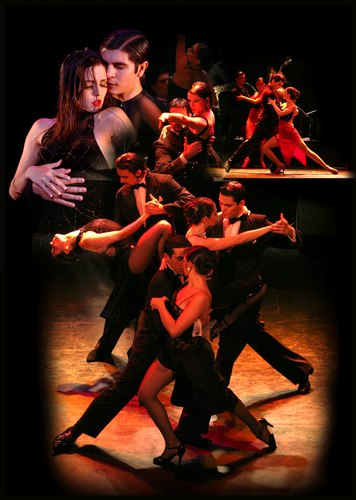|
 |
|
|
 |
 |
Tango Fire is a pure dance show sustained by the excellent quality of its dancing. It doesn't really have a plot, except that Act I is loosely set within a milonga and Act II is loosely set within a stage performance, and there were some brush strokes of characters in Act I. There is no question that someone who is already into Argentine Tango will love Tango Fire. The more difficult question is whether other dance fans will love it too. I think, for the most part, the answer is "Yes, they will love it." I might have liked to have seen a little more variety in what was presented, and perhaps more structure to the evening, but on some level neither were needed: sometimes the quality of the dancing is enough to sustain a full evening show, and that was certainly the case here. Frankly, as a pure dance show, Tango Fire looked right at home at The Joyce, which normally hosts Modern dance and Contemporary Ballet, for the most part. The dancers often took bows after each number, just like ballet dancers, deservedly. Tango Fire showed that partner dances can hold their own in the world of performance dance, which is a very positive sign of progress. The Joyce was completely full, which was another good sign. Nelson Celis, Yanina Fajar, Pablo Sosa, Mariela Maldonado, Cristian Mino, Jorgelina Guzzi, German Cornejo, Carolina Giannini, Cristian Gallardo and Betiana Botana danced to a live, four piece orchestra consisting of Gabriel Clenar on piano, Hugo Satorre on bandoneón, Marcelo Rebuffi on violin and Gerardo Scaglione on double bass. Javier Di Ciriaco sang. Carolina Soler was the artistic director. It might be legitimate to call Tango Fire spectacular, but except for a couple of numbers in Act II, it would be wrong to call the show A spectacular. Much of the dancing looked like advanced social Tango, albeit superb social Tango. It is important that a show be able to succeed this way, because while the show did have enough numbers with expertly executed lifts, drops and spins (the sort of moves that turn a dance into a spectacular), a show with only those sorts of numbers might turn people on to seeing dance, but is less likely to convince them to take some lessons and try it themselves. While this wasn't a show about wine, I think it would be fair to say that Tango Fire was mostly like a great Chardonnay, and less like a flamboyant Champagne. The costumes were exceptional too. A few I particularly liked: a gorgeous blue and gold dress where the gold drew one's eyes to the woman's legs, waist and head - her legs were visible through a long and wide slit in the side; black and colored skirts that flared as they danced paired with sparkly black tops; a lovely aqua dress with a lace top and matching shoes; black velvet dresses with a black translucent mid-section accented with gold trim; a dark grey dress with gold accents; a green dress with a radiant green lace top; a one legged purple pant suit with a wrap; a purple and aqua dress. The footwork was fast and clean. They made difficult moves look easy. Many routines ended with a crisp finish. The dancers were clearly having fun. The main difference between Act I and Act II was that in Act II the lighting was more dramatic and the costumes were flashier. The choreography and moves also were a little more theatrical in Act II. Damion Sanders, who works at OnStage Dancewear, thought the dancing was effortless, like breathing, and that the show was an effortless masterpiece. Mr. Di Ciriaco's voice was melodious. Supertitles would have been very helpful, however, for those in the audience who don't speak Spanish. The orchestra sounded great, and sometimes individual instruments almost seemed to be speaking. Susan Sontag might want to hide the orchestra, but I don't. I thought there was drama in the playing of the instruments. At one point the double bass was even used as a percussion instrument. A few choreography moments that stood out (other than the lifts): at the end of Act I, the women thrust their legs out behind them all at once; also in Act I, a comic dominos moment as one dancer falls into the next, who falls into the next and on down the line; a slide forward that was followed perfectly by the follow spot. After the bows, Hugo Satorre, the bandoneónist, danced with one of the dancers. The moves were simple, but still clean and as beautiful as the rest of the show, as if to say that good dancing doesn't need to be fancy and you, the audience, should try it too. Not that I object to fancy: sometimes in the numbers with the lifts, drops and flying spins, I was wondering "How did she get from there to here?" Magic, I suppose, backed up by a really good partner or a really good insurance policy.
 Tango Fire montage Photo © & courtesy of Mike Keating |
|
|
|


